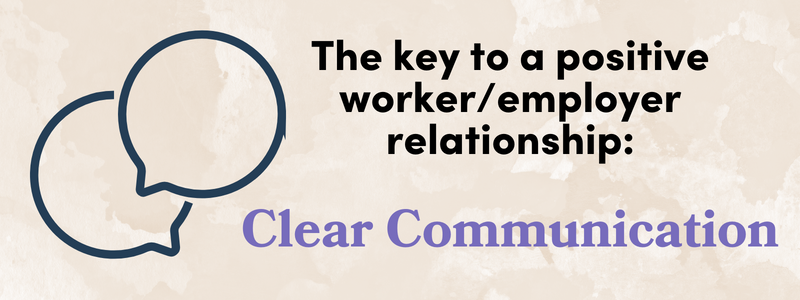Regular Check ins and Annual Evaluations
Should I do regular job evaluations?
In a word: Yes! In any workplace, job evaluations are important opportunities for employers and employees to share affirmations and concerns and make necessary adjustments.
There are two key types of evaluations you should build into your work relationship: annual evaluations or evaluations every six months, and shorter but more frequent check-ins. Here’s how:
Annual Evaluations
Bake it into the job structure
Ideally, you will have established a written work agreement that specifies that evaluations will take place annually, though you might both feel that every six months could be useful.
But if you didn’t…
Try to say something like: “I’d like to plan time for a job evaluation every so often. It’ll be a chance for us to check in and give each other feedback. We’ll focus on what’s working and what could improve.” Raising the idea of a job evaluation out of the blue could set off alarm bells, with the person you employ fearing that you are planning to fire them or that you are very dissatisfied. So mentioning the plan in advance helps prevent any unnecessary concern.
Shorter Check-Ins
In addition to evaluations, you should try to have regular, brief check-ins, even weekly (Fridays can be a good day), to discuss any needed changes. Remember to schedule these short meetings when both of you have the time.
How to Have an Evaluation or Check-In
Talk first
A good way to start is to express your appreciation for everything the work has contributed to your family in the past months or year. You can take this opportunity to share specific, positive observations about their work.
Then you discuss areas where there is room for improvement. Refer to the work agreement if that’s useful. If you do, make sure you both have copies of the agreement.
Then listen
Next, it will be the worker’s chance to tell you where there is room for improvement. Remember that as the employer, you hold power in this conversation. Reassure them that you want to hear what’s really on their mind. They should share any concerns or bring up anything that has been a barrier to fulfilling their responsibilities. The goal of the conversation is to support this worker in doing the vital work they do.
Agree on Next Steps
Together you can outline an action plan that lays out steps everyone will take to address concerns raised in the discussion. Reiterate your appreciation for their hard work and their thoughtfulness in having these conversations with you!
Looking Ahead
An evaluation meeting is a good opportunity to discuss any big changes you want to make to the terms of a worker’s employment (such as reduced or expanded hours) or their responsibilities (a new baby on the way).
Annual evaluation meetings often culminate with a pay increase. A domestic worker’s pay can and should be increased for many reasons, including a change in responsibilities or a change in the hours worked each day, or you could offer a raise based on length of employment.




